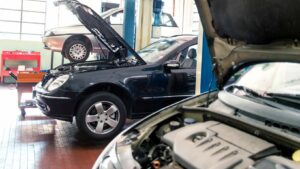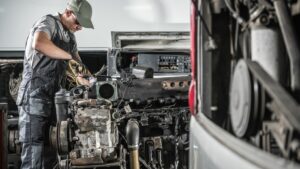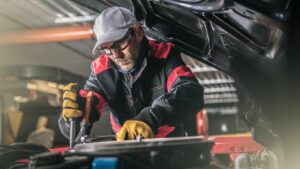In the vast world of automotive care, there’s a hero often unsung – the automotive seam sealer. This essential tool in vehicle maintenance doesn’t just add strength to your car’s structure, it’s also a key player in protecting it from harsh elements.
Seam sealers work behind the scenes, guarding your vehicle against water intrusion, rust, and corrosion. They’re the unsung heroes, often overlooked, but providing a vital service to the longevity and durability of your vehicle.
Automotive Seam Sealer
 Automotive seam sealer turns out to be a vital element in vehicle construction. Its primary function revolves around sealing joints and seams in vehicles’ bodies, often lessening the risk of moisture ingress and consequential corrosion.
Automotive seam sealer turns out to be a vital element in vehicle construction. Its primary function revolves around sealing joints and seams in vehicles’ bodies, often lessening the risk of moisture ingress and consequential corrosion.
Types of Seam Sealers
A variety of seam sealers exist in the automotive marketplace, each having unique properties and uses. Chief among them are brushable seam sealers, self-leveling seam sealers, and sprayable seam sealers.
- Brushable Seam Sealers: These are ideal for vertical applications, say, in door jambs or trunks. They’re applied with a regular brush, allowing for better material control.
- Self-Leveling Seam Sealers: They are designed to flow and fill in gaps, making them suit crevices and overlapping seams. Self-leveling seam sealers necessitate the use of a caulking gun for the application.
- Sprayable Seam Sealers: As the name implies, they’re applied with a spray gun. Sprayable seam sealers’ use works best for recreating original factory textured finishes.
Application Areas in Vehicles
Seam sealer finds its place in various areas of a vehicle. This includes but isn’t limited to floor pans, trunks, and wheelhouses.
- Floor Pans: An essential defensive layer against moisture and road chemicals, seam sealer guarantees the floorboards’ prolonged existence.
- Trunks: The inside corners and seams of trunks can be a hotspot for water collection, hence, seam sealers are of use in averting rust.
- Wheelhouses: Located near the wheel area, the wheelhouses are susceptible to moisture from the road. A layer of seam sealer ensures protection against this.
Benefits of Using Automotive Seam Sealer
 Harnessing the power of automotive seam sealers in vehicle maintenance provides a myriad of advantages. Face to face with elements like water intrusion, rust, corrosion, and structural instability, these sealers emerge as critical allies for any automobile.
Harnessing the power of automotive seam sealers in vehicle maintenance provides a myriad of advantages. Face to face with elements like water intrusion, rust, corrosion, and structural instability, these sealers emerge as critical allies for any automobile.
Corrosion Prevention
Automotive seam sealer proves instrumental in thwarting corrosion. Acting as a barrier, it protects vulnerable areas of the car, such as floor pans, trunks, and wheelhouses, from elements that can lead to rust. By sealing seams, it prevents water and moisture – frequent precursors to corrosion – from breaching these areas. Subsequently, it aids in maintaining the vehicle’s structural integrity and aesthetic appeal, while also potentially extending its lifespan.
Enhanced Durability
An additional perk of automotive seam sealers comes in the form of boosted durability. Seam sealers strengthen the connections between different metal sheets in vehicles, thereby enhancing the overall structural stability. When applied to areas prone to wear and tear – for instance, wheelhouses and floor pans – they fuse the metal parts together, reducing the risk of fractures and disconnections.
Leading Automotive Seam Sealers on the Market
Let’s dive into the finest automotive seam sealers currently making waves in the market. Not only that, but we’ll also review what factors to contemplate when purchasing one to ensure you make a well-informed decision.
Feedback of Popular Brands
 Investigating the automotive industry reveals a few brands universally lauded for their superior seam sealers. 3M Fast ‘N Firm Seam Sealer, for instance, gets thumbs-up for its durability and quick-drying characteristics. Permatex Body Shop Heavy Duty Headliner and Carpet Adhesive, meanwhile, wins points for its high-strength and temperature-resistant feature. Eastwood Brushable Seam Sealer, with its easy-to-apply, durable, and corrosion-resistant properties, also fares well in the market.
Investigating the automotive industry reveals a few brands universally lauded for their superior seam sealers. 3M Fast ‘N Firm Seam Sealer, for instance, gets thumbs-up for its durability and quick-drying characteristics. Permatex Body Shop Heavy Duty Headliner and Carpet Adhesive, meanwhile, wins points for its high-strength and temperature-resistant feature. Eastwood Brushable Seam Sealer, with its easy-to-apply, durable, and corrosion-resistant properties, also fares well in the market.
What to Look for When Buying
Choosing an automotive seam sealer entails a few considerations. First, prioritize the drying time. A quick-drying sealer reduces downtime and helps speed up any maintenance or repair project. Second, consider durability. A long-lasting seam sealer that can withstand conditions like high temperatures and heavy water exposure comes highly recommended. Third, ease of application is vital. Sealers that apply smoothly and easily save time and effort. Finally, contemplate the sealer’s resistance to corrosion. More than just adhering surfaces, a quality sealer protects against harsh elements that can trigger rust and corrosion.



